Abstract
There is a need for practical methods of reinforcer assessment that systematically track ongoing changes in clients' preferences. In this study, the effects of a time-efficient reinforcer assessment package were evaluated in a multiple baseline across 3 preschoolers with autism, comparing individualized item selections by experienced teachers with children's presession preferences for items of various sensory qualities. Systematic assessment of children's reinforcers for correct responding virtually eliminated nontargeted maladaptive behaviors, as well as yielding expected improvements in accuracy. The powerful side-effects of potent reinforcers underline the importance of increased attention to reinforcer assessment in research and practice.
Full text
PDF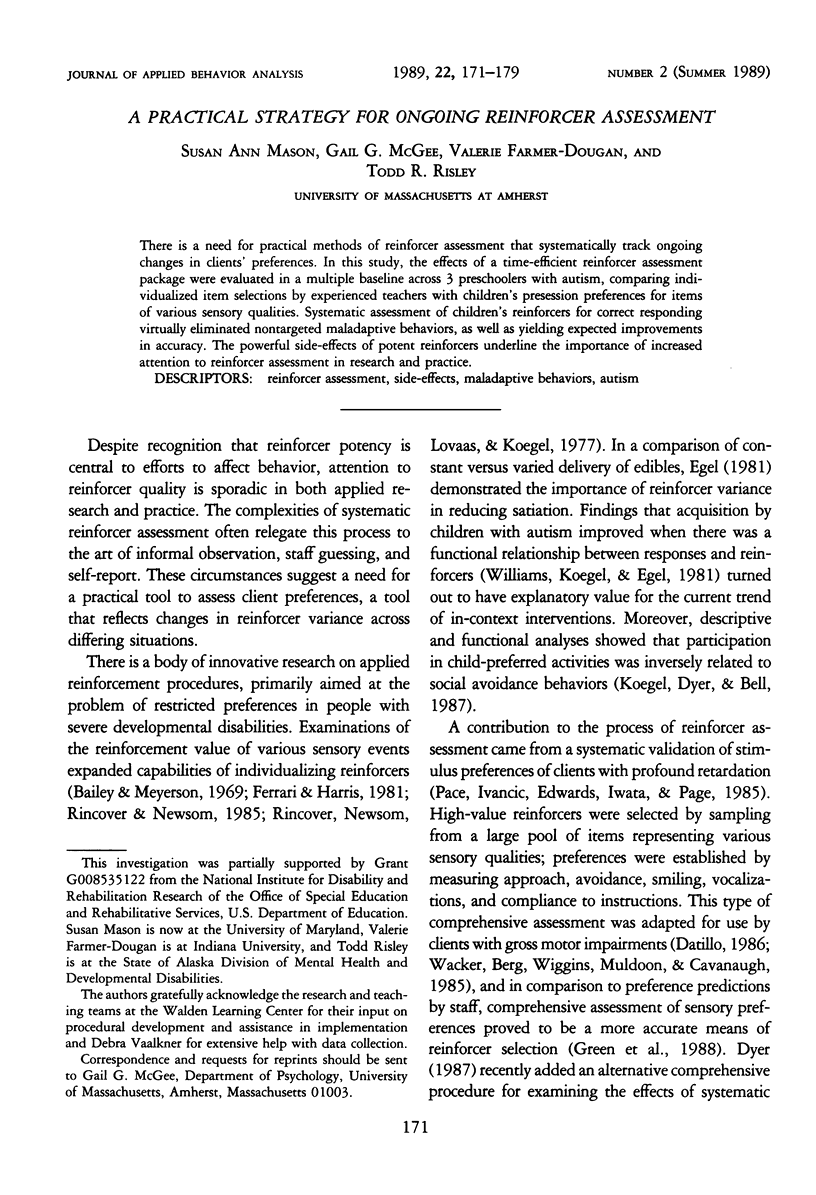



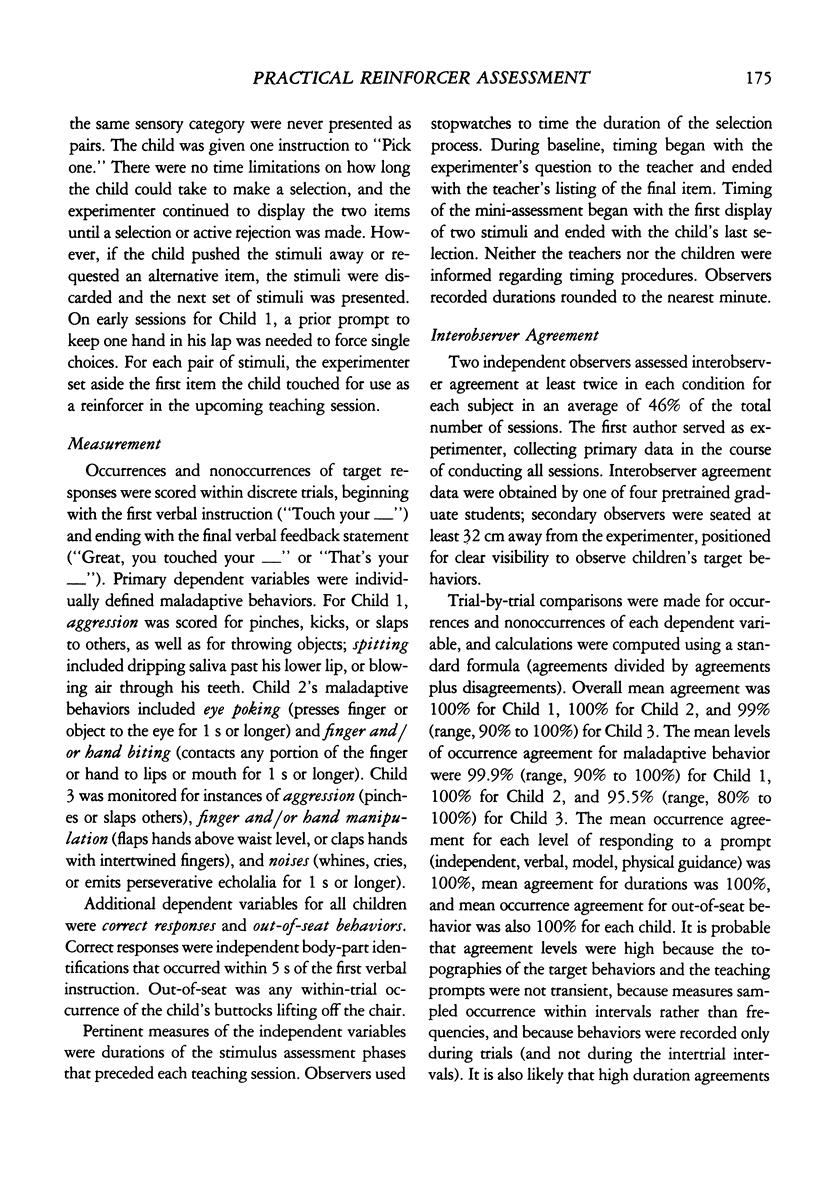

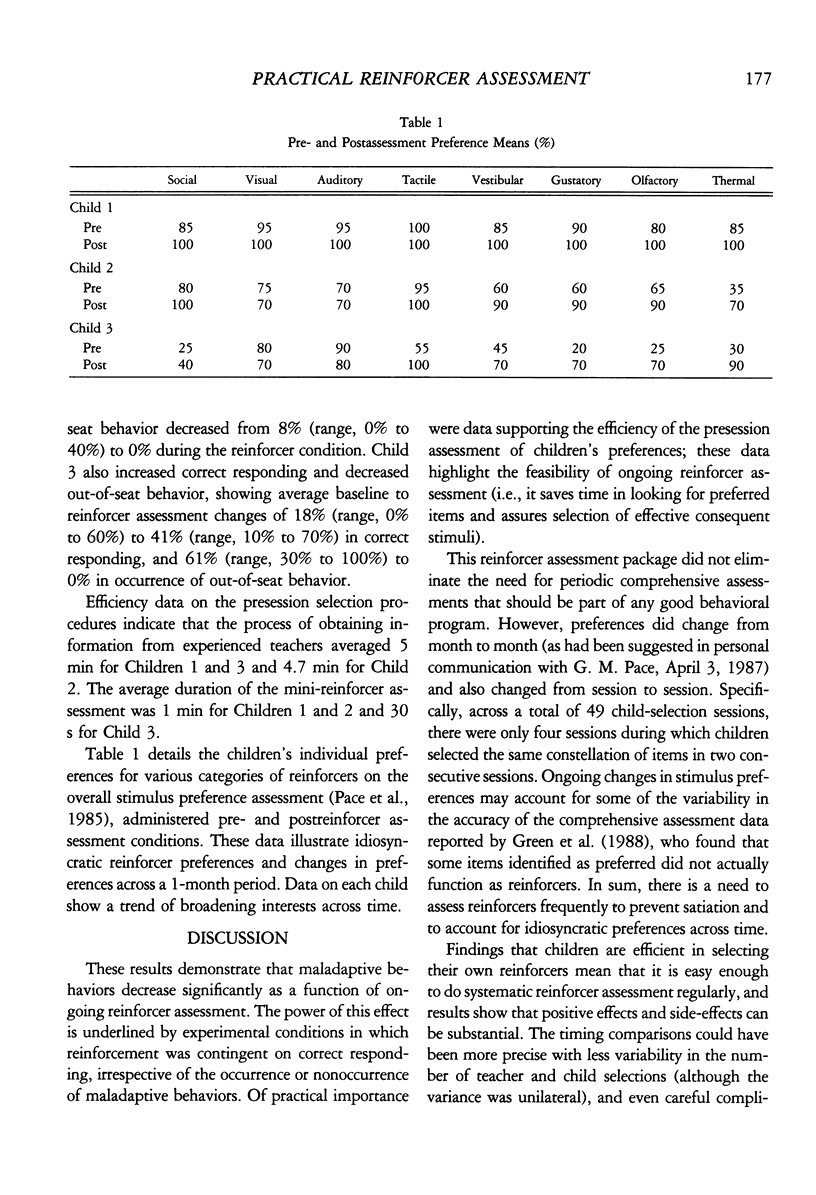
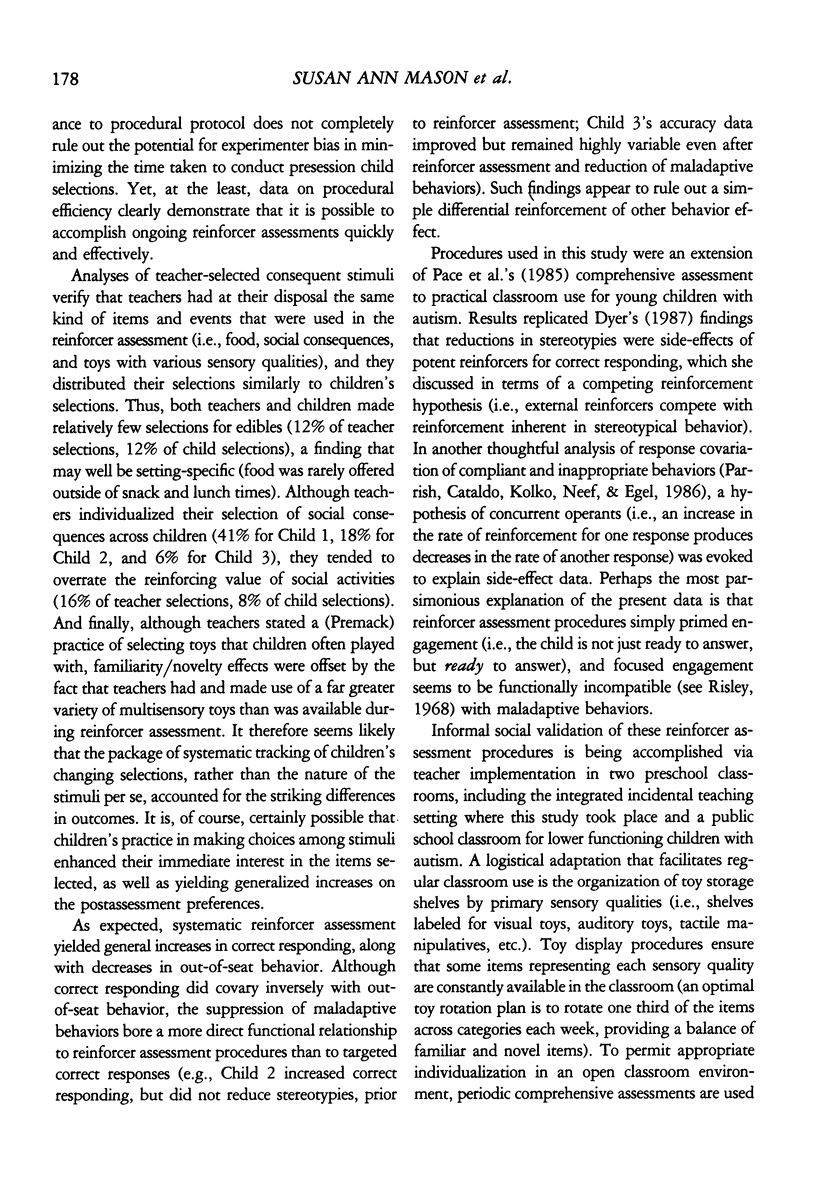
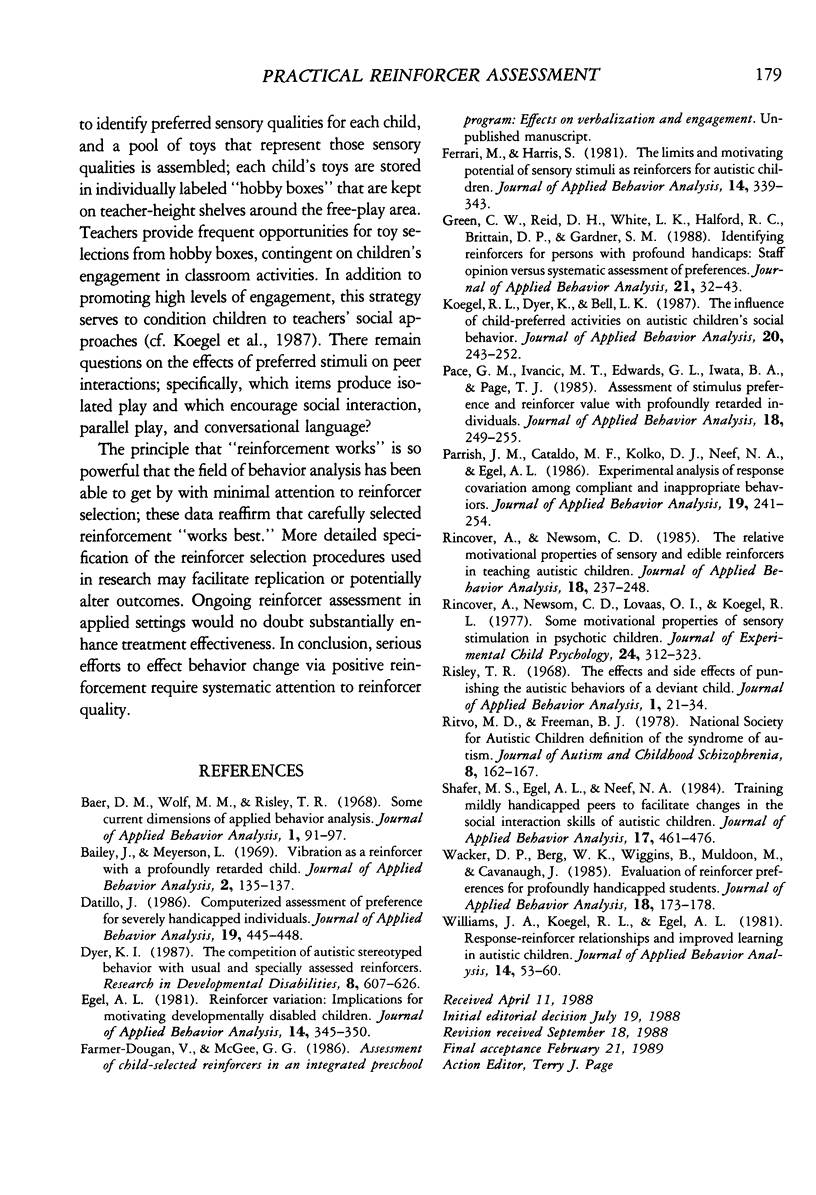
Selected References
These references are in PubMed. This may not be the complete list of references from this article.
- Baer D. M., Wolf M. M., Risley T. R. Some current dimensions of applied behavior analysis. J Appl Behav Anal. 1968 Spring;1(1):91–97. doi: 10.1901/jaba.1968.1-91. [DOI] [PMC free article] [PubMed] [Google Scholar]
- Bailey J., Meyerson L. Vibration as a reinforcer with a profoundly retarded child. J Appl Behav Anal. 1969 Summer;2(2):135–137. doi: 10.1901/jaba.1969.2-135. [DOI] [PMC free article] [PubMed] [Google Scholar]
- Dattilo J. Computerized assessment of preference for severely handicapped individuals. J Appl Behav Anal. 1986 Winter;19(4):445–448. doi: 10.1901/jaba.1986.19-445. [DOI] [PMC free article] [PubMed] [Google Scholar]
- Dyer K. The competition of autistic stereotyped behavior with usual and specially assessed reinforcers. Res Dev Disabil. 1987;8(4):607–626. doi: 10.1016/0891-4222(87)90056-4. [DOI] [PubMed] [Google Scholar]
- Egel A. L. Reinforcer variation: implications for motivating developmentally disabled children. J Appl Behav Anal. 1981 Fall;14(3):345–350. doi: 10.1901/jaba.1981.14-345. [DOI] [PMC free article] [PubMed] [Google Scholar]
- Ferrari M., Harris S. L. The limits and motivating potential of sensory stimuli as reinforcers for autistic children. J Appl Behav Anal. 1981 Fall;14(3):339–343. doi: 10.1901/jaba.1981.14-339. [DOI] [PMC free article] [PubMed] [Google Scholar]
- Green C. W., Reid D. H., White L. K., Halford R. C., Brittain D. P., Gardner S. M. Identifying reinforcers for persons with profound handicaps: staff opinion versus systematic assessment of preferences. J Appl Behav Anal. 1988 Spring;21(1):31–43. doi: 10.1901/jaba.1988.21-31. [DOI] [PMC free article] [PubMed] [Google Scholar]
- Koegel R. L., Dyer K., Bell L. K. The influence of child-preferred activities on autistic children's social behavior. J Appl Behav Anal. 1987 Fall;20(3):243–252. doi: 10.1901/jaba.1987.20-243. [DOI] [PMC free article] [PubMed] [Google Scholar]
- National Society for Autistic Children definition of the syndrome of autism. J Autism Child Schizophr. 1978 Jun;8(2):162–169. doi: 10.1007/BF01537864. [DOI] [PubMed] [Google Scholar]
- Pace G. M., Ivancic M. T., Edwards G. L., Iwata B. A., Page T. J. Assessment of stimulus preference and reinforcer value with profoundly retarded individuals. J Appl Behav Anal. 1985 Fall;18(3):249–255. doi: 10.1901/jaba.1985.18-249. [DOI] [PMC free article] [PubMed] [Google Scholar]
- Parrish J. M., Cataldo M. F., Kolko D. J., Neef N. A., Egel A. L. Experimental analysis of response covariation among compliant and inappropriate behaviors. J Appl Behav Anal. 1986 Fall;19(3):241–254. doi: 10.1901/jaba.1986.19-241. [DOI] [PMC free article] [PubMed] [Google Scholar]
- Rincover A., Newsom C. D., Lovaas O. I., Koegel R. L. Some motivational properties of sensory stimulation in psychotic children. J Exp Child Psychol. 1977 Oct;24(2):312–323. doi: 10.1016/0022-0965(77)90009-1. [DOI] [PubMed] [Google Scholar]
- Rincover A., Newsom C. D. The relative motivational properties of sensory and edible reinforcers in teaching autistic children. J Appl Behav Anal. 1985 Fall;18(3):237–248. doi: 10.1901/jaba.1985.18-237. [DOI] [PMC free article] [PubMed] [Google Scholar]
- Risley T. R. The effects and side effects of punishing the autistic behaviors of a deviant child. J Appl Behav Anal. 1968 Spring;1(1):21–34. doi: 10.1901/jaba.1968.1-21. [DOI] [PMC free article] [PubMed] [Google Scholar]
- Shafer M. S., Egel A. L., Neef N. A. Training mildly handicapped peers to facilitate changes in the social interaction skills of autistic children. J Appl Behav Anal. 1984 Winter;17(4):461–476. doi: 10.1901/jaba.1984.17-461. [DOI] [PMC free article] [PubMed] [Google Scholar]
- Wacker D. P., Berg W. K., Wiggins B., Muldoon M., Cavanaugh J. Evaluation of reinforcer preferences for profoundly handicapped students. J Appl Behav Anal. 1985 Summer;18(2):173–178. doi: 10.1901/jaba.1985.18-173. [DOI] [PMC free article] [PubMed] [Google Scholar]
- Williams J. A., Koegel R. L., Egel A. L. Response-reinforcer relationships and improved learning in autistic children. J Appl Behav Anal. 1981 Spring;14(1):53–60. doi: 10.1901/jaba.1981.14-53. [DOI] [PMC free article] [PubMed] [Google Scholar]


